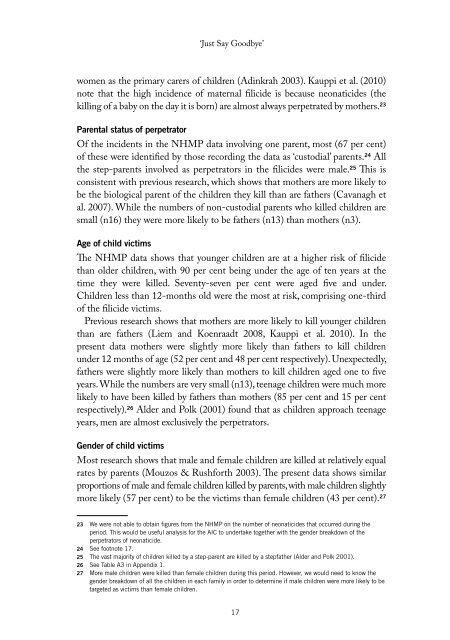‘Just Say Goodbye’ (January 2013 online edition)
‘Just Say Goodbye’ (January 2013 online edition)
‘Just Say Goodbye’ (January 2013 online edition)
- No tags were found...
Create successful ePaper yourself
Turn your PDF publications into a flip-book with our unique Google optimized e-Paper software.
<strong>‘Just</strong> <strong>Say</strong> <strong>Goodbye’</strong>women as the primary carers of children (Adinkrah 2003). Kauppi et al. (2010)note that the high incidence of maternal filicide is because neonaticides (thekilling of a baby on the day it is born) are almost always perpetrated by mothers. 23Parental status of perpetratorOf the incidents in the NHMP data involving one parent, most (67 per cent)of these were identified by those recording the data as ‘custodial’ parents. 24 Allthe step-parents involved as perpetrators in the filicides were male. 25 This isconsistent with previous research, which shows that mothers are more likely tobe the biological parent of the children they kill than are fathers (Cavanagh etal. 2007). While the numbers of non-custodial parents who killed children aresmall (n16) they were more likely to be fathers (n13) than mothers (n3).Age of child victimsThe NHMP data shows that younger children are at a higher risk of filicidethan older children, with 90 per cent being under the age of ten years at thetime they were killed. Seventy-seven per cent were aged five and under.Children less than 12-months old were the most at risk, comprising one-thirdof the filicide victims.Previous research shows that mothers are more likely to kill younger childrenthan are fathers (Liem and Koenraadt 2008, Kauppi et al. 2010). In thepresent data mothers were slightly more likely than fathers to kill childrenunder 12 months of age (52 per cent and 48 per cent respectively). Unexpectedly,fathers were slightly more likely than mothers to kill children aged one to fiveyears. While the numbers are very small (n13), teenage children were much morelikely to have been killed by fathers than mothers (85 per cent and 15 per centrespectively). 26 Alder and Polk (2001) found that as children approach teenageyears, men are almost exclusively the perpetrators.Gender of child victimsMost research shows that male and female children are killed at relatively equalrates by parents (Mouzos & Rushforth 2003). The present data shows similarproportions of male and female children killed by parents, with male children slightlymore likely (57 per cent) to be the victims than female children (43 per cent). 2723 We were not able to obtain figures from the NHMP on the number of neonaticides that occurred during theperiod. This would be useful analysis for the AIC to undertake together with the gender breakdown of theperpetrators of neonaticide.24 See footnote 17.25 The vast majority of children killed by a step-parent are killed by a stepfather (Alder and Polk 2001).26 See Table A3 in Appendix 1.27 More male children were killed than female children during this period. However, we would need to know thegender breakdown of all the children in each family in order to determine if male children were more likely to betargeted as victims than female children.17


